《数据库系统概念 Database System Concepts》原书教学资源(第六版,PPT课件讲稿,英文版)Chapter 23 XML
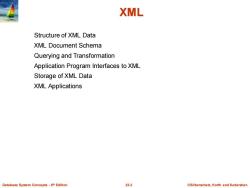
XML Structure of XML Data XML Document Schema Querying and Transformation Application Program Interfaces to XML Storage of XML Data XML Applications Database System Concepts-6th Edition 23.2 @Silberschatz,Korth and Sudarshan
Database System Concepts - 6 23.2 ©Silberschatz, Korth and Sudarshan th Edition XML Structure of XML Data XML Document Schema Querying and Transformation Application Program Interfaces to XML Storage of XML Data XML Applications
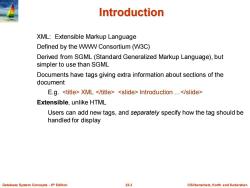
Introduction XML:Extensible Markup Language Defined by the W Consortium (W3C) Derived from SGML(Standard Generalized Markup Language),but simpler to use than SGML Documents have tags giving extra information about sections of the document E.g.XML Introduction... Extensible,unlike HTML Users can add new tags,and separately specify how the tag should be handled for display Database System Concepts-6th Edition 23.3 @Silberschatz,Korth and Sudarshan
Database System Concepts - 6 23.3 ©Silberschatz, Korth and Sudarshan th Edition Introduction XML: Extensible Markup Language Defined by the WWW Consortium (W3C) Derived from SGML (Standard Generalized Markup Language), but simpler to use than SGML Documents have tags giving extra information about sections of the document E.g. XML Introduction … Extensible, unlike HTML Users can add new tags, and separately specify how the tag should be handled for display

XML Introduction (Cont.) The ability to specify new tags,and to create nested tag structures make XML a great way to exchange data,not just documents. Much of the use of XML has been in data exchange applications,not as a replacement for HTML Tags make data(relatively)self-documenting E.g. Comp.Sci. Taylor 100000 CS-101 Intro.to Computer Science Comp.Sci 4 Database System Concepts-6th Edition 23.4 @Silberschatz,Korth and Sudarshan
Database System Concepts - 6 23.4 ©Silberschatz, Korth and Sudarshan th Edition XML Introduction (Cont.) The ability to specify new tags, and to create nested tag structures make XML a great way to exchange data, not just documents. Much of the use of XML has been in data exchange applications, not as a replacement for HTML Tags make data (relatively) self-documenting E.g. Comp. Sci. Taylor 100000 CS-101 Intro. to Computer Science Comp. Sci 4
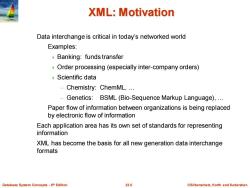
XML:Motivation Data interchange is critical in today's networked world Examples: Banking:funds transfer Order processing (especially inter-company orders) Scientific data Chemistry:ChemML,... -Genetics:BSML (Bio-Sequence Markup Language),.. Paper flow of information between organizations is being replaced by electronic flow of information Each application area has its own set of standards for representing information XML has become the basis for all new generation data interchange formats Database System Concepts-6th Edition 23.5 @Silberschatz,Korth and Sudarshan
Database System Concepts - 6 23.5 ©Silberschatz, Korth and Sudarshan th Edition XML: Motivation Data interchange is critical in today’s networked world Examples: Banking: funds transfer Order processing (especially inter-company orders) Scientific data – Chemistry: ChemML, … – Genetics: BSML (Bio-Sequence Markup Language), … Paper flow of information between organizations is being replaced by electronic flow of information Each application area has its own set of standards for representing information XML has become the basis for all new generation data interchange formats
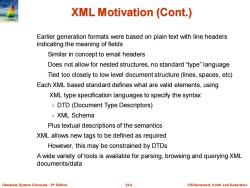
XML Motivation (Cont.) Earlier generation formats were based on plain text with line headers indicating the meaning of fields Similar in concept to email headers Does not allow for nested structures,no standard "type"language Tied too closely to low level document structure(lines,spaces,etc) Each XML based standard defines what are valid elements,using XML type specification languages to specify the syntax DTD(Document Type Descriptors) XML Schema Plus textual descriptions of the semantics XML allows new tags to be defined as required However,this may be constrained by DTDs A wide variety of tools is available for parsing,browsing and querying XML documents/data Database System Concepts-6th Edition 23.6 ©Silberschat乜,Korth and Sudarshan
Database System Concepts - 6 23.6 ©Silberschatz, Korth and Sudarshan th Edition XML Motivation (Cont.) Earlier generation formats were based on plain text with line headers indicating the meaning of fields Similar in concept to email headers Does not allow for nested structures, no standard “type” language Tied too closely to low level document structure (lines, spaces, etc) Each XML based standard defines what are valid elements, using XML type specification languages to specify the syntax DTD (Document Type Descriptors) XML Schema Plus textual descriptions of the semantics XML allows new tags to be defined as required However, this may be constrained by DTDs A wide variety of tools is available for parsing, browsing and querying XML documents/data
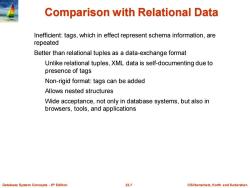
Comparison with Relational Data Inefficient:tags,which in effect represent schema information,are repeated Better than relational tuples as a data-exchange format Unlike relational tuples,XML data is self-documenting due to presence of tags Non-rigid format:tags can be added Allows nested structures Wide acceptance,not only in database systems,but also in browsers,tools,and applications Database System Concepts-6th Edition 23.7 @Silberschatz,Korth and Sudarshan
Database System Concepts - 6 23.7 ©Silberschatz, Korth and Sudarshan th Edition Comparison with Relational Data Inefficient: tags, which in effect represent schema information, are repeated Better than relational tuples as a data-exchange format Unlike relational tuples, XML data is self-documenting due to presence of tags Non-rigid format: tags can be added Allows nested structures Wide acceptance, not only in database systems, but also in browsers, tools, and applications
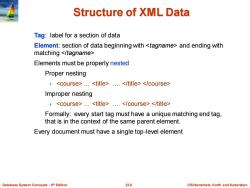
Structure of XML Data Tag:label for a section of data Element:section of data beginning with and ending with matching Elements must be properly nested Proper nesting ....... Improper nesting ....... Formally:every start tag must have a unique matching end tag, that is in the context of the same parent element. Every document must have a single top-level element Database System Concepts-6th Edition 23.8 @Silberschatz,Korth and Sudarshan
Database System Concepts - 6 23.8 ©Silberschatz, Korth and Sudarshan th Edition Structure of XML Data Tag: label for a section of data Element: section of data beginning with and ending with matching Elements must be properly nested Proper nesting … …. Improper nesting … …. Formally: every start tag must have a unique matching end tag, that is in the context of the same parent element. Every document must have a single top-level element

Example of Nested Elements P-101 .... RS1 Atom powered rocket sled 2 199.95 SG2 Superb glue 1 liter 29.95 Database System Concepts-6th Edition 23.9 @Silberschatz,Korth and Sudarshan
Database System Concepts - 6 23.9 ©Silberschatz, Korth and Sudarshan th Edition Example of Nested Elements P-101 …. RS1 Atom powered rocket sled 2 199.95 SG2 Superb glue 1 liter 29.95

Motivation for Nesting Nesting of data is useful in data transfer Example:elements representing item nested within an itemlist element Nesting is not supported,or discouraged,in relational databases With multiple orders,customer name and address are stored redundantly normalization replaces nested structures in each order by foreign key into table storing customer name and address information Nesting is supported in object-relational databases But nesting is appropriate when transferring data External application does not have direct access to data referenced by a foreign key Database System Concepts-6th Edition 23.10 @Silberschatz,Korth and Sudarshan
Database System Concepts - 6 23.10 ©Silberschatz, Korth and Sudarshan th Edition Motivation for Nesting Nesting of data is useful in data transfer Example: elements representing item nested within an itemlist element Nesting is not supported, or discouraged, in relational databases With multiple orders, customer name and address are stored redundantly normalization replaces nested structures in each order by foreign key into table storing customer name and address information Nesting is supported in object-relational databases But nesting is appropriate when transferring data External application does not have direct access to data referenced by a foreign key

Structure of XML Data (Cont.) Mixture of text with sub-elements is legal in XML. Example: This course is being offered for the first time in 2009. BIO-399 Computational Biology Biology 3 Useful for document markup,but discouraged for data representation Database System Concepts-6th Edition 23.11 @Silberschatz,Korth and Sudarshan
Database System Concepts - 6 23.11 ©Silberschatz, Korth and Sudarshan th Edition Structure of XML Data (Cont.) Mixture of text with sub-elements is legal in XML. Example: This course is being offered for the first time in 2009. BIO-399 Computational Biology Biology 3 Useful for document markup, but discouraged for data representation
按次数下载不扣除下载券;
注册用户24小时内重复下载只扣除一次;
顺序:VIP每日次数-->可用次数-->下载券;
- 《数据库系统概念 Database System Concepts》原书教学资源(第六版,PPT课件讲稿,英文版)Chapter 22 Object-Based Databases.ppt
- 《数据库系统概念 Database System Concepts》原书教学资源(第六版,PPT课件讲稿,英文版)Chapter 21 Information Retrieval.ppt
- 《数据库系统概念 Database System Concepts》原书教学资源(第六版,PPT课件讲稿,英文版)Chapter 20 Data Analysis.ppt
- 《数据库系统概念 Database System Concepts》原书教学资源(第六版,PPT课件讲稿,英文版)Chapter 2 Introduction to the Relational Model.ppt
- 《数据库系统概念 Database System Concepts》原书教学资源(第六版,PPT课件讲稿,英文版)Chapter 19 Distributed Databases.ppt
- 《数据库系统概念 Database System Concepts》原书教学资源(第六版,PPT课件讲稿,英文版)Chapter 18 Parallel Databases.ppt
- 《数据库系统概念 Database System Concepts》原书教学资源(第六版,PPT课件讲稿,英文版)Chapter 17 Database System Architectures.ppt
- 《数据库系统概念 Database System Concepts》原书教学资源(第六版,PPT课件讲稿,英文版)Chapter 16 Recovery System.ppt
- 《数据库系统概念 Database System Concepts》原书教学资源(第六版,PPT课件讲稿,英文版)Chapter 15 Concurrency Control.ppt
- 《数据库系统概念 Database System Concepts》原书教学资源(第六版,PPT课件讲稿,英文版)Chapter 14 Transactions.ppt
- 《数据库系统概念 Database System Concepts》原书教学资源(第六版,PPT课件讲稿,英文版)Chapter 13 Query Optimization.ppt
- 《数据库系统概念 Database System Concepts》原书教学资源(第六版,PPT课件讲稿,英文版)Chapter 12 Query Processing.ppt
- 《数据库系统概念 Database System Concepts》原书教学资源(第六版,PPT课件讲稿,英文版)Chapter 11 Indexing and Hashing.ppt
- 《数据库系统概念 Database System Concepts》原书教学资源(第六版,PPT课件讲稿,英文版)Chapter 10 Storage and File Structure.ppt
- 《数据库系统概念 Database System Concepts》原书教学资源(第六版,PPT课件讲稿,英文版)Chapter 1 Introduction(Avi Silberschatz Henry F. Korth S. Sudarshan).ppt
- 电子科技大学:《大数据时代商业模式创新 Business model innovation》研究生课程教学资源(课件讲稿,杜义飞).pdf
- 电子科技大学:《大数据时代商业模式创新 Business model innovation》研究生课程教学资源(讲座)换一个视角看清商业本质.pdf
- 电子科技大学:《大数据时代商业模式创新 Business Model Innovation in the Times of Big Data》研究生课程教学资源(教学大纲,杜义飞).pdf
- 《物联网技术导论 Introduction of Internet of Things》课程教学资源(参考文献)群智感知计算(清华大学:在后台操纵的同时,用户对于污染、扭曲文字的识 刘云浩).pdf
- 南京大学:《物联网技术导论 Introduction of Internet of Things》课程教学资源(参考文献)基于位置服的务(架构与研究进展).pdf
- 《数据库系统概念 Database System Concepts》原书教学资源(第六版,PPT课件讲稿,英文版)Chapter 24 Advanced Application Development.ppt
- 《数据库系统概念 Database System Concepts》原书教学资源(第六版,PPT课件讲稿,英文版)Chapter 25 Advanced Data Types and New Applications.ppt
- 《数据库系统概念 Database System Concepts》原书教学资源(第六版,PPT课件讲稿,英文版)Chapter 26 Advanced Transaction Processing.ppt
- 《数据库系统概念 Database System Concepts》原书教学资源(第六版,PPT课件讲稿,英文版)Chapter 3 Introduction to SQL.ppt
- 《数据库系统概念 Database System Concepts》原书教学资源(第六版,PPT课件讲稿,英文版)Chapter 4 Intermediate SQL.ppt
- 《数据库系统概念 Database System Concepts》原书教学资源(第六版,PPT课件讲稿,英文版)Chapter 5 Advanced SQL.ppt
- 《数据库系统概念 Database System Concepts》原书教学资源(第六版,PPT课件讲稿,英文版)Chapter 6 Formal Relational Query Languages.ppt
- 《数据库系统概念 Database System Concepts》原书教学资源(第六版,PPT课件讲稿,英文版)Chapter 7 Database Design - The Entity-Relationship Approach.ppt
- 《数据库系统概念 Database System Concepts》原书教学资源(第六版,PPT课件讲稿,英文版)Chapter 8 Relational Database Design.ppt
- 《数据库系统概念 Database System Concepts》原书教学资源(第六版,PPT课件讲稿,英文版)Chapter 9 Application Design and Development.ppt
- 《数据库系统概念 Database System Concepts》原书教学资源(第六版,附录,英文版)Advanced Relational Database Design.pdf
- 《数据库系统概念 Database System Concepts》原书教学资源(第六版,附录,英文版)Other Relational Query Languages.pdf
- 《数据库系统概念 Database System Concepts》原书教学资源(第六版,附录,英文版)Network Model.pdf
- 《数据库系统概念 Database System Concepts》原书教学资源(第六版,附录,英文版)Hierarchical Model.pdf
- 《数据库系统概念 Database System Concepts》原书教学资源(第五版,附录,英文版)Chapter A Network Model.ppt
- 《数据库系统概念 Database System Concepts》原书教学资源(第五版,附录,英文版)Chapter B Hierarchical Model.ppt
- 《数据库系统概念 Database System Concepts》原书教学资源(第五版,附录,英文版)Appendix C Advanced Relational Database Design.ppt
- 《数据库系统概念 Database System Concepts》原书教学资源(第五版,PPT课件讲稿,英文版)Chapter 1 Introduction(Avi Silberschatz Henry F. Korth S. Sudarshan).ppt
- 《数据库系统概念 Database System Concepts》原书教学资源(第五版,PPT课件讲稿,英文版)Chapter 10 XML.ppt
- 《数据库系统概念 Database System Concepts》原书教学资源(第五版,PPT课件讲稿,英文版)Chapter 11 Storage and File Structure.ppt
